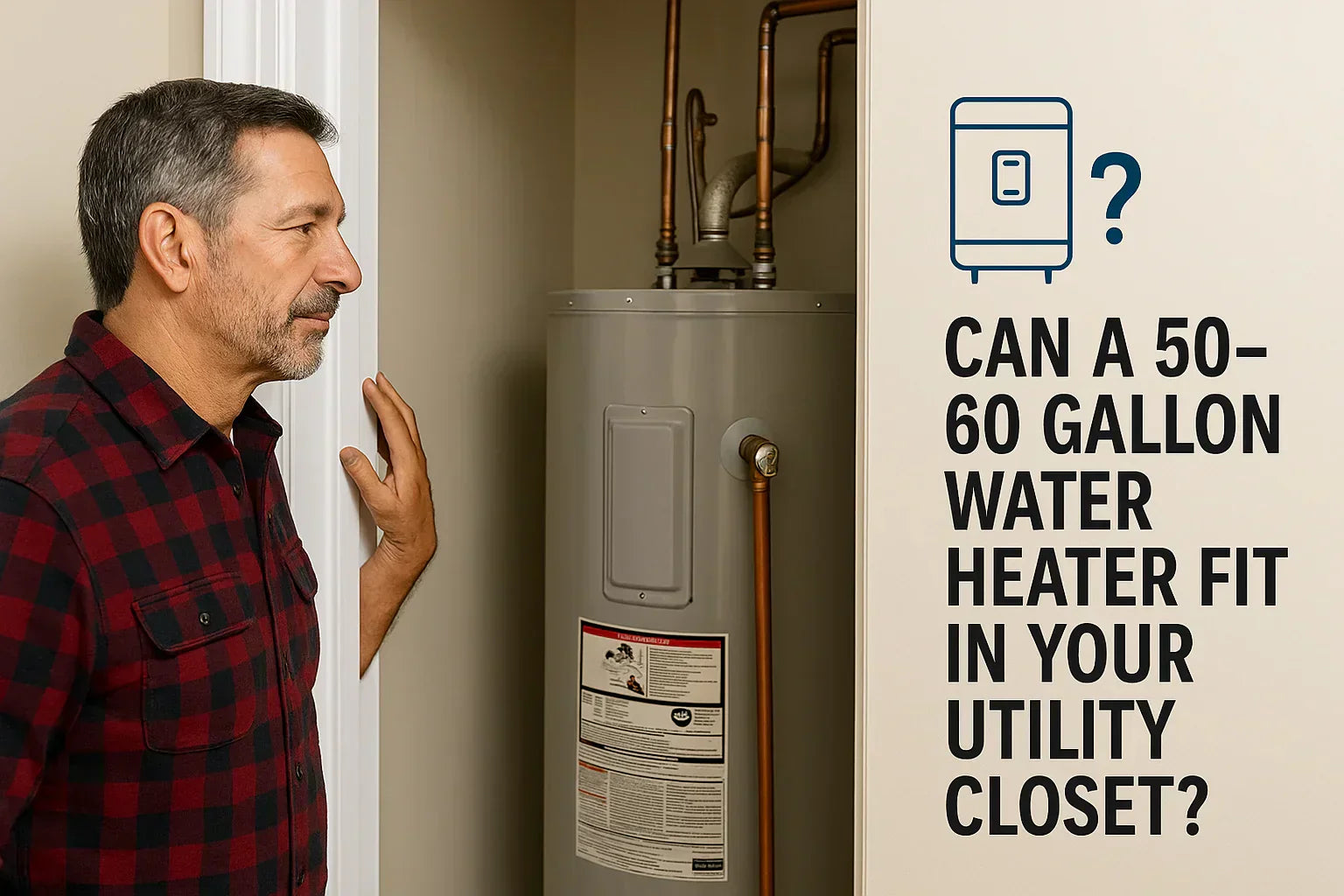If you're planning to upgrade or install a 50- or 60-gallon electric water heater, one of the biggest questions on your mind is probably this: Will it fit in my utility closet?
For homeowners like Mike who value comfort, energy savings, and smart use of space, this isn’t just a minor detail. Getting this part wrong can mean more than just a tight squeeze—it could cost you in installation headaches, code violations, or the need to return a brand-new unit.
This in-depth guide explores everything you need to know to confidently answer that question.
🏠 Typical Dimensions of 50–60 Gallon Water Heaters
Let’s start with the physical specs.
Standard Tall Models
-
50-Gallon Tank: ~58" to 62" tall, 20" to 24" diameter
-
60-Gallon Tank: ~62" to 66" tall, 22" to 28" diameter
Short/Lowboy Models
-
Height: 30" to 49"
-
Wider diameter: 26" to 32" wide
Weight When Empty:
-
50-Gallon: 115–135 lbs
-
60-Gallon: 140–160 lbs
Pro Tip: Check manufacturer spec sheets for exact dimensions. Sites like Rheem or AO Smith make this easy.
🧰 Measure Your Utility Closet First
Critical Measurements to Take:
-
Clear height: floor to ceiling (subtract room for drain pan)
-
Clear width: inside wall-to-wall
-
Depth: front to back, including door clearance
-
Door opening width: especially important in older homes
Minimum clearances required:
-
2-3" side clearance
-
6-12" above tank for TPR valve and anode rod access
-
24" front clearance for service access
🌟 Options for Tight Spaces
If your utility closet is a tight fit, you have several options:
1. Choose a Short (Lowboy) Water Heater
-
Ideal for crawl spaces and under-counter locations
-
Same gallon capacity in a squat profile
-
May be slightly more expensive and heavier
2. Install a Side-Connect Model
-
Plumbing connections on the side, not top
-
Reduces vertical clearance needed
-
Often used in manufactured or modular homes
3. Use Remote Expansion Tanks
-
If space is too tight for a tank-mounted expansion vessel
-
Mount it nearby in the ceiling or wall cavity
4. Cut Out a Pocket in Wall Framing
-
Adds 1-2 inches of space where needed
-
Check with a contractor for code compliance
⚠️ Code Requirements You Can't Ignore
Before you even consider fitting a 50- or 60-gallon tank into a tight spot, know what your local building and plumbing codes require.
IRC / UPC General Requirements:
-
TPR valve must be accessible
-
Drain pan required if above living space
-
18" elevation from floor if installed in a garage
-
Proper combustion air (if gas)
Electric-only? You skip venting issues, but still need:
-
30A dedicated circuit (240V)
-
Proper grounding & bonding
-
Protection from freezing or water damage
See NFPA 70 for full code references.
🛠️ Installation Tips for Utility Closets
1. Use Flexible Water Connectors
-
Makes it easier to maneuver in tight quarters
-
Helps absorb vibration
2. Pre-install the Drain Pan
-
Slide the heater onto it instead of trying to install later
3. Use a Dolly or Lifting Strap
-
Even empty, these tanks are bulky
-
Protect your flooring and yourself
4. Install a Shut-Off Valve Outside the Closet
-
Makes future maintenance safer and easier
🌿 Ventilation and Heat Management
Though electric heaters don't require combustion air, they do radiate heat and benefit from airflow:
-
Leave 3" behind the tank to avoid trapped heat
-
If installing in a sealed closet, consider adding a louvered door or vent grate
-
Hybrid electric models need more airflow than standard models
If you’re considering an ENERGY STAR model with a heat pump.
🧐 Real-World Closet Fit Examples
Mike’s Basement Closet
-
64" tall ceiling, 28" wide interior
-
Upgraded from 50 to 60-gallon using a short model
-
Added a wall-mounted expansion tank and flexible connectors
Townhome Utility Closet
-
70" ceiling but only 23" door opening
-
Used a 50-gallon lowboy model with side connections
-
Removed bi-fold doors and added a louvered cover panel
Garage Install
-
66" height, plenty of space
-
Used a 60-gallon tall model with a drain pan
-
Code required 18" elevation platform
📍 Conclusion: Will It Fit?
A 50-gallon electric water heater will fit in most utility closets, especially if you're replacing an existing tank of similar size. A 60-gallon unit? That depends:
It will fit if:
-
You have a clear 60+ inches of height
-
You use a short or side-connect model
-
The door opening is at least 24"
It might not fit if:
-
Your closet is narrow and shallow
-
You have tight front clearance
-
You’re in a mobile home or apartment with limited space
🧠 Mike's Final Advice
If you're not sure what your closet can accommodate, don’t guess. Measure it. Compare spec sheets. And plan around the clearances, not just the tank diameter.
Choosing the right 50- or 60-gallon model might involve a few trade-offs in layout or height, but with the right prep, you’ll avoid cold showers and busted drywall.
Use the Furnace Outlet Sizing Guide to filter by tank dimensions and make sure your new heater is a perfect fit—no hammer required.
In the next topic we will know more about: How Much Hot Water Do You Really Use? First Hour Rating Explained







